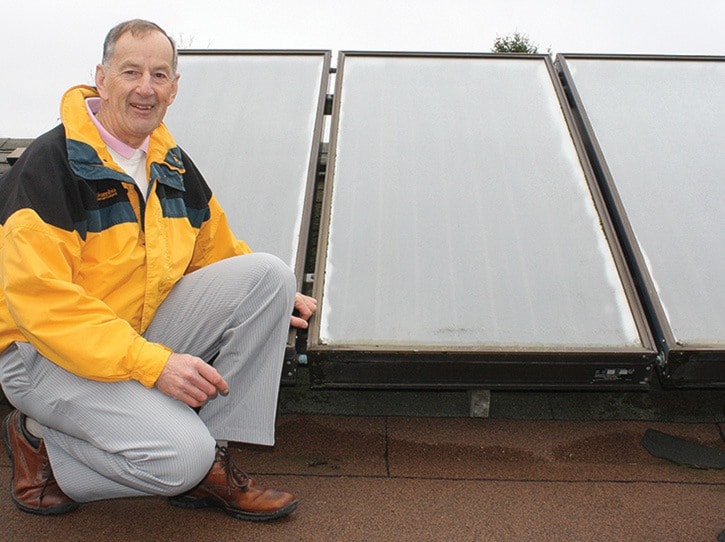A federal subsidy program that aims to increase solar hot water systems in the Capital Region is set to expire this month, but another 14 Saanich homes are now less dependent on electricity or gas.
A total of 81 residents and businesses received subsidies between $2,500 and $4,000 through the Solar CRD program, a program that began in Colwood in 2011 and was later rolled out across the region.
Saanich’s Mike Mcreesh had no intentions of installing a solar hot water system, but his contractor suggested he consider it during recent renovations.
“It kind of fell into my lap but it’s really worked out, I certainly recommend it to anyone,” said Mcreesh, who lives in the Quadra neighbourhood near Beckwith Park. “I can’t get over the growing number of total solar hours collected by the machine. I get a kick out of seeing it on the display screen of the unit, it’s quite substantial.”
Depending on the size of the system, Solar CRD covered approximately a third of the cost of a solar hot water system, while commercial subsidies went up to $25,000 per application.
Solar CRD’s grant program officially run out March 31, so it’s unlikely new applicants can take advantage this year. (March 20 is the deadline to have the solar hot water system installed, functioning and licensed in order to ensure timely processing and payment of the Solar CRD incentives, said a Solar CRD spokesperson.)
“We had enough money for 100 residential subsidies and reached 81. So, for the most part, we’re happy with the success,” said Solar CRD’s Glen Harris, senior manager with the CRD’s environmental protection. “We also had a few commercial installations which we’re thrilled about.”
At this point, there has been no discussion of extending or re-creating the program, though Harris pointed out the CRD’s Tap by Tap program has expanded to provide multi-unit buildings with up to 3,000 units with free water and energy saving fixtures, such as shower heads and faucet aerators.
Tap by Tap’s low-flow fixtures have made headway in reducing water use in the region, but the level of residential solar energy falls squarely on those willing to pay for the start-up cost.
Saanich Coun. Vic Derman installed a solar hot water system at his Lucas Avenue home in 1981.
The efficiency of his system is a far cry from the latest technology but it’s a workhorse nonetheless, even in the winter, Derman said.
“It was $4,000 back then with a 50 per cent ($2,000) subsidy from the federal government, which was trying to ease Canada’s reliance on oil due it’s high prices of the time,” Derman said.
“Certainly I’d like to see incentive programs continue but not necessarily through the CRD, but the real trend is for the utility companies, in our case B.C. Hydro, to become managers of distribution systems, not just hydro companies, and practise in a more environmentally friendly manner.”
Rather than homeowners paying thousands of dollars for either a solar hot water system or solar voltaic panels (that tie into the grid), or both, some utility companies are installing them for free, a model Derman believes should be considered.
“The homeowner orders it up and then pays it back on a 10 year schedule, or whatever it takes,” he said. “Instead of paying hundreds each month for electricity, homeowners pay a monthly bill for the equipment to (partially) supply their home with electricity and/or hot water.”
There is an expectation in Texas that solar energy will be compete with natural gas next year, as the price of natural gas drops, partly due to the advancement of solar power.
reporter@saanichnews.com
